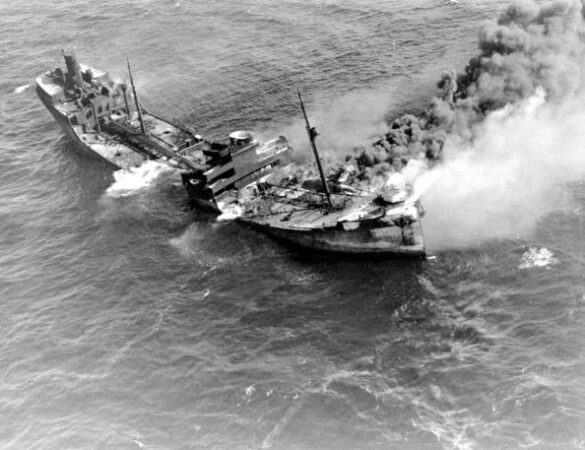Editor’s note: The following story is reprinted with the permission of the authors of A History of Submarine Warfare along the Jersey Shore (The History Press, ©2016, available from retail booksellers everywhere).
By Joseph G. Bilby & Harry Ziegler
It was just after midnight on February 27, 1942, and the R. P. Resor, built at the Kearny, New Jersey shipyard in 1935 and named after Standard Oil Treasurer Rubin Perry Resor, was sailing up the New Jersey coast about eighteen miles east of Barnegat Light. The Standard Oil tanker had shipped out of Baytown, Texas with a cargo of 78,729 barrels of fuel oil to deliver to Fall River, Massachusetts.
The Resor was following all U.S. Navy anti-submarine instructions, sailing in a zigzag manner with all lights out, radios off and with a deck gun manned by Navy “armed guards” day and night. John K. Forsdal, the ship’s lookout, spotted some flashing lights between his ship and the shore, thought they indicated a fishing boat, and alerted the captain to avoid a possible collision. Moments later, however, his vessel experienced a “searing explosion” as a German torpedo hit her amidships. The Resor was immediately engulfed in flames, and the resulting “spectacular towering fire” was visible from as far away as the Asbury Park boardwalk and the Belmar Coast Guard station. Forsdal recalled: “I was lifted off the deck and I was unconscious for a second or two. When I came to, I saw the whole aft aflame.” He looked towards shore in the blazing light and saw – the silhouette of a surfaced German U-Boat, U-578, a Type VIIC submarine.
Forsdal dropped a life raft overboard, jumped into the oily water and grasped on to it with fellow crewman Clarence E. Armstrong. When they saw a Coast Guard boat, CG 4344, approaching several hours later, both men screamed for help. The Coast Guard managed to save Forsdal, although it took several men to pull his oil coated body aboard, but Armstrong slipped under the waves. The CG 4344 sailed as close as it could to the burning Resor, and later reported that “the sides of the ship were white hot” and that the paint on the side of CG 4344 was “blistered” by the intense heat.
The Neutrality Act of 1936 prohibited arming merchant ships, but, with war raging in Europe, German submarines and aircraft roaming the Atlantic, and the importance of sea lanes to logistical support, Section 6 of the Neutrality Act, the specific legislation barring the practice, was repealed on November 17, 1941, and the Navy began to arm these vessels with four- and five-inch deck guns and machine guns, many of which were installed in Hoboken, New Jersey, and assign and train crews, known as “armed guards,” to man the weapons. Navy Coxswain Daniel Hey, a member of the eight man “armed guard” detailed to man the deck gun on Resor, was sleeping in his bunk when the torpedo hit, and ran up to the deck, where he and three other men tried and failed to launch a lifeboat through the flames. They all jumped overboard and Hey swam for an hour and a half before he was picked up, alone, by a rescue boat. Forsdal and Hey, their bodies covered with heavy oil, were the only survivors of the R.P. Resor. Over the next day, “one body was picked up at sea by a Coast Guard patrol crew and three other bodies were reported sighted floating in the oil clogged waters off Manasquan Inlet.” Forty-one merchant seamen and eight Navy personnel on board failed to survive the attack.

A newspaper reported that the resulting “blanket of fire, which turned into a pall of smoke as the morning and afternoon wore on, could be seen for hours afterward.” Forsdal and Hey were brought to the Manasquan Coast Guard station where the oil was washed off their bodies and they posed for a photo – the two luckiest men on the New Jersey shore that day. Later in the afternoon journalists took a boat out from Manasquan to photograph the smoldering wreck, which was still afloat, and spotted three more bodies floating in the oil slick around the Resor. The hulk floated on fire for two days, providing a tourist attraction for crowds on area boardwalks before an attempt to tow it to shore for salvage failed. The sinking of the R.P. Resor brought World War II home dramatically to Monmouth County and New Jersey.

About the Authors:
Joseph G. Bilby received his BA and MA degrees in history from Seton Hall University and served as lieutenant in the First Infantry Division in Vietnam in 1966-67. He is assistant curator of the New Jersey National Guard Militia Museum in Sea Girt, a columnist for the Civil War News and New Jersey Sportsmen News, and a freelance writer, historian and historical consultant. He is the author, editor or co-author of more than four hundred articles and twenty-two books on New Jersey, the Civil War, and firearms history. Mr. Bilby has received the Jane Clayton Award for contributions to Monmouth County, New Jersey history; an award of merit from the New Jersey Historical Commission for his contributions to the state’s military history; and the New Jersey Meritorious Service Medal from the state’s Division of Military and Veterans Affairs. In 2018, he was awarded the Richard J. Hughes Prize by the New Jersey Historical Commission for his lifelong contributions to New Jersey history.
Harry Ziegler received his BA degree in English from Monmouth University and his M.Ed. from Georgian Court University and worked for many years at the Asbury Park Press, New Jersey’s second largest newspaper. He rose from reporter to bureau chief, editor and managing editor of the paper. He is now principal of Saint Thomas Aquinas High School in Edison, New Jersey, and this book on the submarine warfare of New Jersey is the eighth book he has authored on New Jersey history.
Sources:
Bilby, Joseph G., & Ziegler, Harry. (2006). A History of Submarine Warfare along the Jersey Shore. The History Press, Charleston, S.C., 2016.
Gentile, Gary. (1988). Shipwrecks of New Jersey. Sea Sports Publications, Norwalk, Conn., 1988.
Hickam Jr., Homer. (1989). Torpedo Junction: U-Boat War Off America’s East Coast, 1942. Naval Institute Press, Annapolis, Md., P. 51.
Taylor, Theodore. (1958). Fire on the Beaches: The Dramatic Story of the Struggle Between the American Merchant Marine and the U-boats. W.W. Norton & Co., Inc., New York, N.Y., 1958, P. 95.
Two Tankers Torpedoed, One 18 Miles Off Jersey. (1942). The New York Times, February 28, 1942, P. 1, 3.
Image credit: Oil tanker R.P. Resor aflame, by New York Daily News Archive, Getty Images license.
Images of R.P. Resor survivors courtesty National Guard Militia Museum of New Jersey, used by permission.


My Grandfather was first mate on Resor. I’d love any info about this disaster. His name William Mengleson.
The best account I’ve read is A History of Submarine Warfare along the Jersey Shore from The History Press, by Joe Bilby and Harry Ziegler.
My mama’s younger brother was a gunner aboard the Resor. I am interested in any information about this ship and those who lost their lives. His name is James Linwood (J.L) Jones.
Hi…I suggest you connect with the people at the New Jersey Maritime Museum, located in Beach Haven, in Ocean County (https://njmaritimemuseum.org/),as they have possibly the most extensive records on shipwrecks in the area. You might also check with the New Jersey Shipwreck Museum, part of the InfoAge complex in Wall. That museum is primarily artifacts from deep sea divers, the museum represents the New Jersey Historical Divers Association(https://njhda.org/).
Hope this helps! John
My father is Daniel Leo Hey, who was one of the two survivors. I never knew this website existed.
Wow, so, did your father ever talk about that experience? Would love to share anything he might have told you about that! – John
My Father was an Engineer on this ship – in the Engine room and was cut open by a pipe that was struck. He was rescued and taken to the hospital. His name was John Van Gilson.
Thanks for sharing your story!